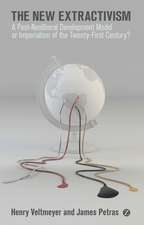Life Cycle Assessment in the Agri-food Sector: Case Studies, Methodological Issues and Best Practices
Editat de Bruno Notarnicola, Roberta Salomone, Luigia Petti, Pietro A. Renzulli, Rocco Roma, Alessandro K. Ceruttien Limba Engleză Hardback – 20 ian 2015
Preț: 652.49 lei
Preț vechi: 767.63 lei
-15% Nou
Puncte Express: 979
Preț estimativ în valută:
124.86€ • 130.69$ • 103.92£
124.86€ • 130.69$ • 103.92£
Carte tipărită la comandă
Livrare economică 31 martie-14 aprilie
Preluare comenzi: 021 569.72.76
Specificații
ISBN-13: 9783319119397
ISBN-10: 3319119397
Pagini: 420
Ilustrații: XXI, 390 p.
Dimensiuni: 155 x 235 x 22 mm
Greutate: 0.75 kg
Ediția:2015
Editura: Springer International Publishing
Colecția Springer
Locul publicării:Cham, Switzerland
ISBN-10: 3319119397
Pagini: 420
Ilustrații: XXI, 390 p.
Dimensiuni: 155 x 235 x 22 mm
Greutate: 0.75 kg
Ediția:2015
Editura: Springer International Publishing
Colecția Springer
Locul publicării:Cham, Switzerland
Public țintă
ResearchCuprins
Foreword.- Preface.- 1 Life Cycle Assessment in the agri-food sector: an overview of its key aspects, international initiatives, certification, labelling schemes and methodological issues.- 2 Life cycle assessment in the olive oil sector.- 3 Life Cycle Assessment in the wine sector.- 4 Life cycle assessment in the cereal and derived products sector.- 5 Life cycle assessment in the livestock and derived edible products sector.- 6 Life cycle assessment in the fruit sector.- Conclusions.
Recenzii
“The book is well organized and full of useful information. … the editors deserve credit for developing a fairly consistent chapter format that supports the flow of the text while ensuring good coverage of the chosen themes. … This work is a welcome addition to the current literature on food life cycle assessments and sustainability.” (Mary Ann Curran, The International Journal of Life Cycle Assessment, Vol. 21, 2016)
Textul de pe ultima copertă
This book examines environmental hotspots, methodological issues and best practices for the agri-food sector from a life cycle perspective. The aim is to create practical guidelines for the LCA community and the main actors of the agro-food chains: farmers, manufacturing companies, consumers and others. The book is focused on some of the most relevant and productive agri-food supply chains, including olive oil, wine, cereals and derived products, meats, dairy products and fruit.
The first chapter introduces key concerns, applications, and methodological uncertainties of the application of life cycle assessment (LCA) principles and practices to the agri-food sector, offering an overview of the main dietary issues, which acknowledges the importance of consumer behaviour. Chapter 2 focuses on the olive oil industry, an economically significant sector. The authors undertake a review of international LCA implementation, a description of LCA implementation problems and application guidelines. The third chapter surveys the wine sector, offering a critical review of existing LCA methodologies and case studies, and a description of scientifically sound environmental improvements suggested by published LCAs. Chapter 4 covers the principal cereal and derived products, presents conclusions and describes the main hot spots in the cereal supply chain. Chapter 5 explores livestock and derived edible products, a sector which has an important economical role and which is associated with adverse environmental effects, covering LCA implementations, methodological problems and best practices. The final chapter focuses on fruit products, among the less environmentally damaging foods in western diets. After an overview of the European fruit industry, the authors discuss methodological problems concerned with the application of LCA to the sector and propose practical guidelines.
The first chapter introduces key concerns, applications, and methodological uncertainties of the application of life cycle assessment (LCA) principles and practices to the agri-food sector, offering an overview of the main dietary issues, which acknowledges the importance of consumer behaviour. Chapter 2 focuses on the olive oil industry, an economically significant sector. The authors undertake a review of international LCA implementation, a description of LCA implementation problems and application guidelines. The third chapter surveys the wine sector, offering a critical review of existing LCA methodologies and case studies, and a description of scientifically sound environmental improvements suggested by published LCAs. Chapter 4 covers the principal cereal and derived products, presents conclusions and describes the main hot spots in the cereal supply chain. Chapter 5 explores livestock and derived edible products, a sector which has an important economical role and which is associated with adverse environmental effects, covering LCA implementations, methodological problems and best practices. The final chapter focuses on fruit products, among the less environmentally damaging foods in western diets. After an overview of the European fruit industry, the authors discuss methodological problems concerned with the application of LCA to the sector and propose practical guidelines.
Caracteristici
Update of all the methodological problems of Food LCA Reviews LCA studies on main foods from five economically important food sectors Defines methodological issues, identifies hot spots and reviews practical guidelines in each food sector Includes supplementary material: sn.pub/extras







